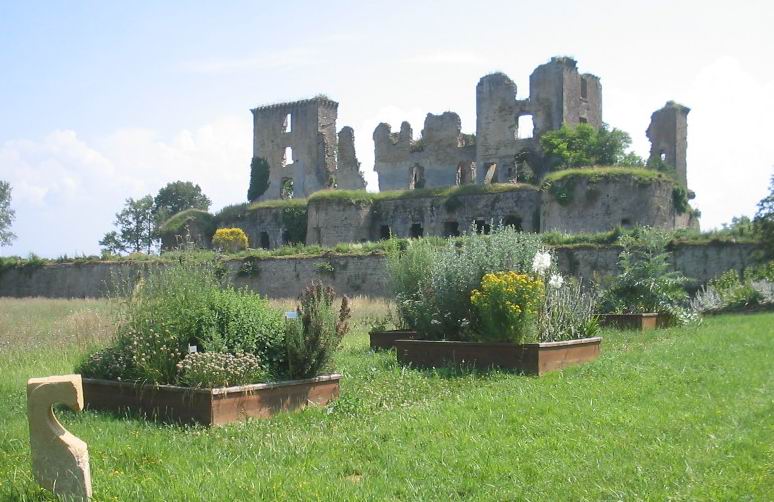Château De Lagarde on:
[Wikipedia]
[Google]
[Amazon]
 The Château de Lagarde is a ruined
The Château de Lagarde is a ruined
 The Château de Lagarde is a ruined
The Château de Lagarde is a ruined castle
A castle is a type of fortification, fortified structure built during the Middle Ages predominantly by the nobility or royalty and by Military order (monastic society), military orders. Scholars usually consider a ''castle'' to be the private ...
situated near the village of Lagarde, southeast of Mirepoix
A mirepoix ( , ) is a mixture of diced vegetables cooked with fat (usually butter) for a long time on low heat without coloring or browning. The ingredients are not sautéed or otherwise hard-cooked, because the intention is to sweeten rather t ...
in the French ''département
In the administrative divisions of France, the department (, ) is one of the three levels of government under the national level (" territorial collectivities"), between the administrative regions and the communes. There are a total of 101 ...
'' of Ariège.
Following the Albigensian Crusade
The Albigensian Crusade (), also known as the Cathar Crusade (1209–1229), was a military and ideological campaign initiated by Pope Innocent III to eliminate Catharism in Languedoc, what is now southern France. The Crusade was prosecuted pri ...
, the castle was handed to the Lévis-Mirepoix family. It was fortified but, over time, it was modified to provide a more comfortable residence. During the French Revolution, the castle was partially destroyed, but it remains today as a bold silhouette looking down over the valley. The ruins comprise several towers and curtain walls.
Château de Lagarde has been listed as a ''monument historique
() is a designation given to some national heritage sites in France. It may also refer to the state procedure in France by which national heritage protection is extended to a building, a specific part of a building, a collection of buildings, ...
'' by the French Ministry of Culture
The Ministry of Culture () is the ministry (government department), ministry of the Government of France in charge of List of museums in France, national museums and the . Its goal is to maintain the French identity through the promotion and pro ...
since 1914.
History
The first documented mention of Lagarde is from the 10th century. The first castle was a square tower with, in the corner, a circular covering tower, built in the 11th century. In the 12th century, four square towers were added as well as a rectangular gatehouse, the whole castle being linked by walls witharrowslit
An arrowslit (often also referred to as an arrow loop, loophole or loop hole, and sometimes a balistraria) is a narrow vertical aperture in a fortification through which an archer can launch arrows or a crossbowman can launch Crossbow bolt, bolts ...
s and crenellation
A battlement, in defensive architecture, such as that of city walls or castles, comprises a parapet (a defensive low wall between chest-height and head-height), in which gaps or indentations, which are often rectangular, occur at intervals t ...
s. In the 14th century, the structure underwent important alterations. Buildings were erected behind each façade, the roofs were raised, a drawbridge
A drawbridge or draw-bridge is a type of moveable bridge typically at the entrance to a castle or tower surrounded by a moat. In some forms of English, including American English, the word ''drawbridge'' commonly refers to all types of moveable b ...
was built and the entry gate and building openings were modified. In the 16th century, a large hanging spiral staircase
Stairs are a structure designed to bridge a large vertical direction, vertical distance between lower and higher levels by dividing it into smaller vertical distances. This is achieved as a diagonal series of horizontal platforms called steps wh ...
was built (1526) with a flamboyant Gothic vault. Also in this period, the castle was doubled in size with the addition of walls and vaults, a new moat
A moat is a deep, broad ditch dug around a castle, fortification, building, or town, historically to provide it with a preliminary line of defence. Moats can be dry or filled with water. In some places, moats evolved into more extensive water d ...
was created with four circular bastion
A bastion is a structure projecting outward from the curtain wall of a fortification, most commonly angular in shape and positioned at the corners of the fort. The fully developed bastion consists of two faces and two flanks, with fire from the ...
s in the corners and the drawbridge entrance was also bastioned. 17th century modifications included the addition of monumental statues on the bastions and the staircase tower, the creation of an esplanade surrounded by fortifications in the southeast, the replacement of the drawbridge by a stone bridge with a monumental gateway, and an access ramp leading from the village.
See also
*List of castles in France
This is a list of castles in France, arranged by Regions of France, region and Departments of France, department.
;Notes:
# The French word ''château'' has a wider meaning than the English ''castle'': it includes architectural entities that are p ...
References
External links
* Monuments historiques of Ariège (department) Ruined castles in Occitania (administrative region) {{France-castle-stub